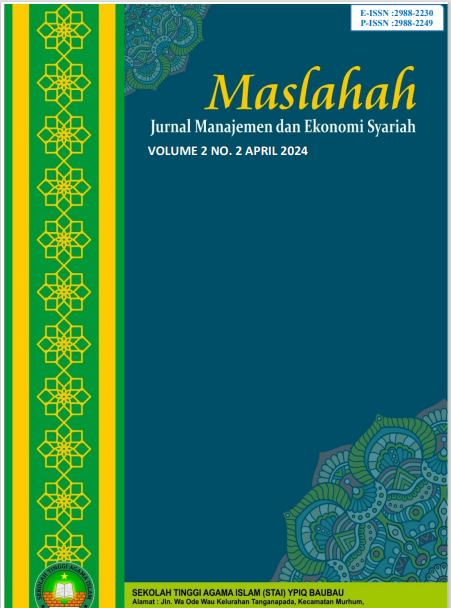Pemikiran Ekonomi: Imam Al-Syaibani
DOI:
https://doi.org/10.59059/maslahah.v3i1.2016Keywords:
Al-Syabani, Work, EconomyAbstract
Imam al-Syaibani was an Islamic economic thinker who lived at the time of Abu Yusuf and was one of the pioneers in the spread and development of the Hanafi school of thought. Al-Syaibani's economic thinking can be seen in the Book of al-Kasb, al-lhtisab fi al-Rizq al-Mustahab, and the book of al-Asi which discusses income, guidelines for production and consumption behavior, various forms of business such as trade, agriculture, industry and employment agreement. Al-Syaibani's economic thinking in the current context is still very relevant, especially the concept of al-kasb which must refer to utility and benefit.
References
Afrida. (2003). Ekonomi sumber daya manusia. Ghalla.
Al-Mubarak, A. A. (n.d.). Pemikiran ekonomi Islam Al-Syaibani: Kontribusi dalam ilmu ekonomi. Penerbit.
Al-Sarakhsi. (2008). Menguak pemikiran ekonomi Islam klasik. Aqwam.
Chapra, M. U. (n.d.). The Islamic vision of development in the light of Maqasid al-Shariah. Islamic Research and Training Institute.
Hasan, Z. (n.d.). Al-Syaibani and his economic thought: A contemporary analysis. International Journal of Islamic Economics.
Kahf, M. (n.d.). Islamic economics: Its contribution to thought and practice. Penerbit.
Karim, A. A. (2004). Sejarah pemikiran ekonomi Islam (2nd ed.). PT Raja Grafindo Persada.
Karim, A. A. (2006). Sejarah pemikiran ekonomi Islam. Raja Grafindo Persada.
Mohammed, M. O. (2011). Economic consumption model revisited: Infaq based on Al-Shaybani’s levels of Al-Kasb. International Journal of Economics, Management and Accounting, 19(3), 115–132.
Pradesyah, R., & Nur Aulia. (2020). Pengaruh pembiayaan murabahah dan musyarakah terhadap profitabilitas pada PT. Bank Syariah Mandiri. Aghniya Jurnal Ekonomi Islam, 731-743.
Rahmani. (2010). Pemikiran ekonomi Islam Abu Yusuf. MUQTASID Jurnal Ekonomi dan Perbankan Syariah, 342-351.
Schafran, A., McDonald, C., Morales, E. L., & Akyelken, N. (2018). Replacing the services sector and three-sector theory: Urbanization and control as economic sectors. Regional Studies, 0(0), 1–12. https://doi.org/10.1080/00343404.2018.1464136
Setia, A. (2012). Imam Muhammad Ibn Al-Hasan Al-Shaybānī on earning a livelihood: Seven excerpts from his Kitāb Al-Kasb. Islam & Science, 10(2), 99–116. http://search.ebscohost.com/login.aspx?direct=true&db=a9h&AN=84609401&site=ehost-live
Siddiqi, M. N. (n.d.). Recent works on the history of economic thought in Islam: A survey. Islamic Economics Studies, Vol(No), Halaman.
Syaibani, M. B. (1986). Al Iktisab Fi Al Rizq Al Mustahab. Beirut: Dar Al Kutub Al Imiyyah.
Zamzam Fakhry. (2016). Pemikiran ekonomi Imam Al-Syaibani. Economica Sharia, 2(1), 19–28.
Downloads
Published
How to Cite
Issue
Section
License
Copyright (c) 2024 Maslahah : Jurnal Manajemen dan Ekonomi Syariah

This work is licensed under a Creative Commons Attribution-ShareAlike 4.0 International License.







